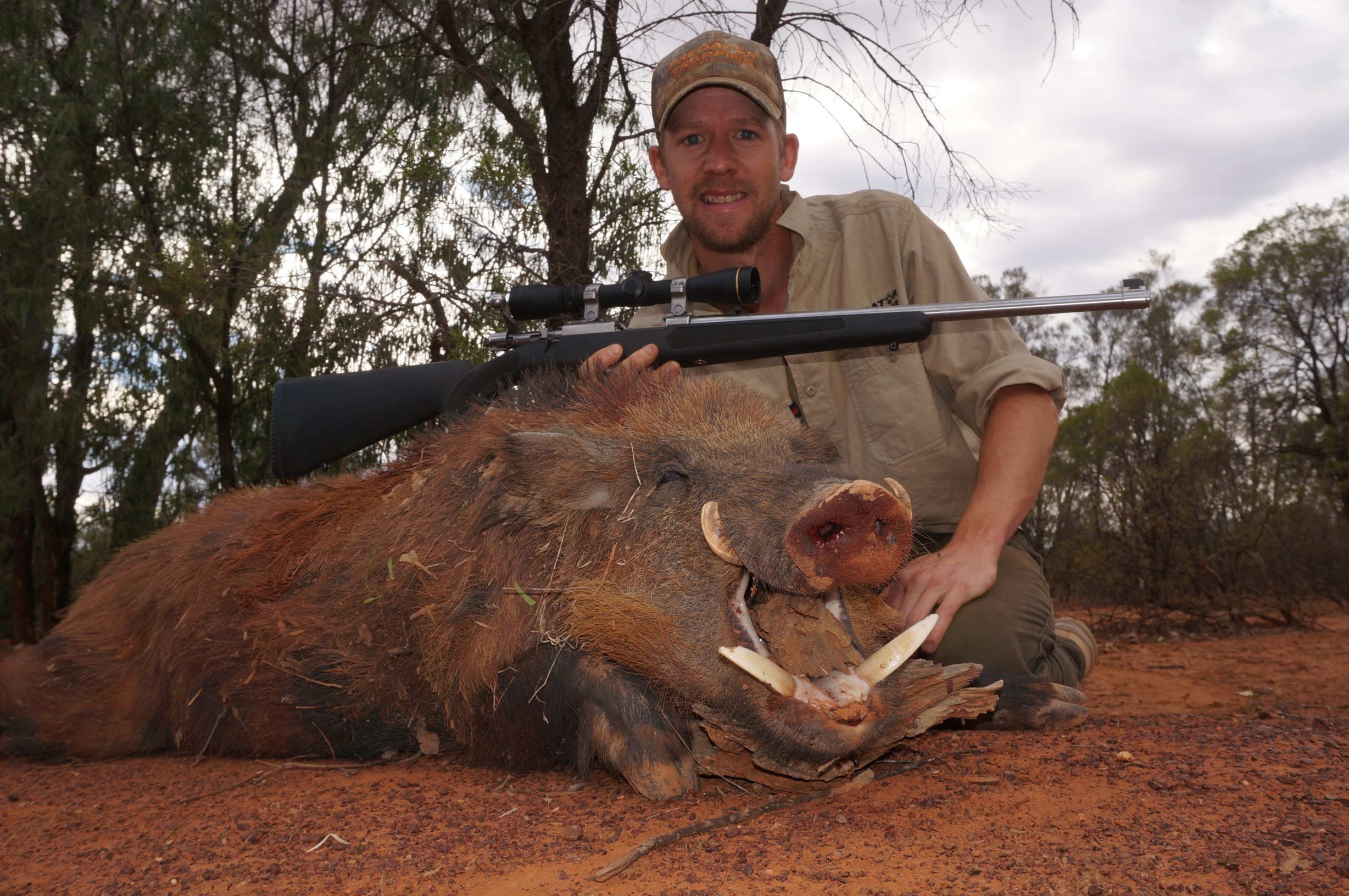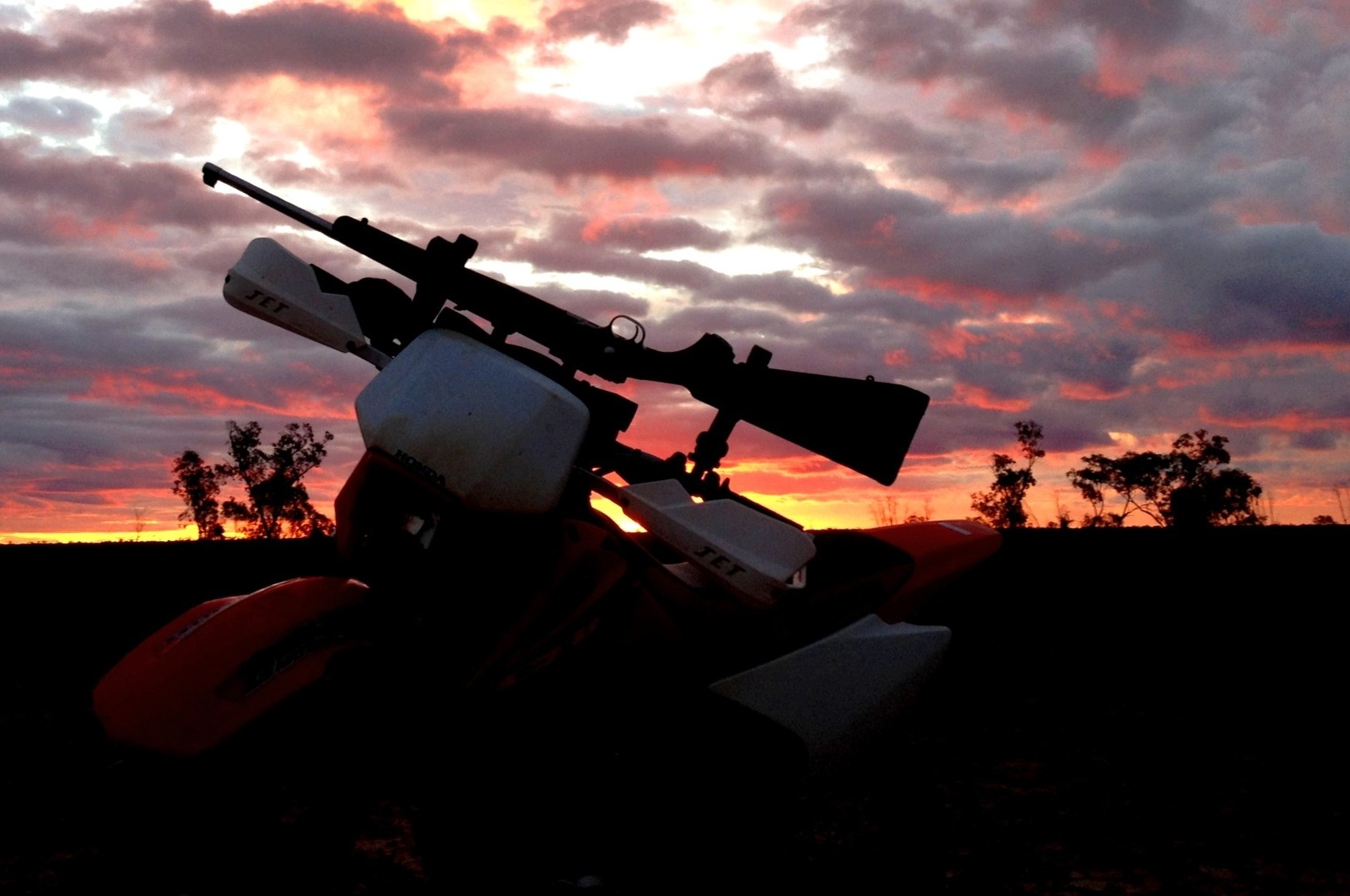
The biggest boars are little challenge for the .357 in the right hands.
Pro trapper Matt Beach gives the Ruger 77/357 a thorough test targeting feral predators on the trapline.
One of the dilemmas with selecting a rifle to use on the trapline is that one rifle just doesn’t seem to cover all of the situations a trapper will run across. At each end of the spectrum we have a trapped animal dispatch rifle that is suited to a low powered calibre while at the other end we want a higher powered rifle for the occasions when wild dogs, pigs, foxes and other game animals are encountered at large on the trapline.
Rimfires are the perfect choice for dispatch but are lacking in power and range for longer shots on medium game. The last rifle you want in your hands when a big tusky boar jumps up in front is a .22LR! That exact moment is when you would be glad to be shouldering a .308 (or your own favourite calibre) although it is much too loud and powerful for dispatch of a wild dog in a trap from a couple of metres away.
An easy solution is to carry two rifles, a rimfire for dispatch and a higher power centrefire for those bigger critters at large. This usually works when vehicle based and covers most situations but isn’t always possible when on foot, motorbike or horseback and sometimes it’s just a hassle to be carting around two rifles and two lots of gear to suit.
Another option is a middle ground calibre that will do both jobs adequately with some compromise. Some middle ground type calibres that come to mind are the .17HMR, .22 Hornet and .223. They all have disadvantages on a trapline and can be too powerful for some situations but not enough gun at others.
There is one other contender in this category that has an advantage – the .357 Magnum. With full power loads it will deal with medium game at short to moderate ranges. The beauty of the .357 is the ability to run lower power .38 Special loads. Down loaded target .38 SPL loads go off with just a pop and cause very little damage to the target. So we get the best of both worlds – enough oomph and not much oomph in the same rifle.
There are also a few other requirements that are needed for a rifle to be become a true “trapgun”. Tough, light and handy. Enter the Ruger 77/357.

Foxes and wild dogs are all fair game for the pro trapper.
Like the rest of the 77 series, it’s tough. It isn’t refined and high class but it is rugged and reliable which is exactly what a trapline rifle needs to be. It will get dusty, wet, muddy, sweaty, sun-baked and icy. It will also get bumped around the truck, motorbike or on horseback and probably won’t get quite as much cleaning and maintenance as it should. If you’re going to rough up a rifle, it is a good idea to choose a Ruger!
I’ve been using the 77/357 for some professional wild dog control jobs during the last year and have been able to give it a thorough test in the field. Apart from initial sighting in and an occasional shot to check zero, it has entirely been used out in the scrub targeting feral predators. This rifle hasn’t fired a single group but the results in the field have shown that accuracy is more than adequate for regular trapline purposes.
A Leupold VXIII 2-7×33 provides for both short and longer range tasks that this rifle is used for. The compact variable scope also fits perfectly with the handy carbine style of the rifle. I deliberately picked the Leupold to be able to survive the bumps and shakes of the trapline without worrying about big dollar optics in the dust, scrub and mud.
Dust, scrub and mud is what this rifle has had to deal with and more! A November trapline in Southwest Queensland brought 43 degree temperatures, sweat and coatings of the fine red outback dust. July tested both trapper and rifle with alternating sub zero frosts, dust, rain and mud while being bounced about and whipped by mulga regrowth on the handlebars of a motorbike.
Stainless steel isn’t stain free but the ruger steel is renowned as being about as good as it gets for rust resistance in a rifle. It certainly survived the rigours of the trapline without a single spot of rust despite not getting regular wipes with a gun cloth. The synthetic stock was only slightly blemished despite the bumps and scrapes on the bike and in the scrub. Well I guess that ticks the tough box.
Light. Well it’s just over 3kg (a tad under 7 pounds) with 2-7×33 leupold and a full magazine. I reckon that makes it light enough without being an ultralight. I found it easy to carry one handed when wandering around looking for dog sign at dams or running off into the scrub when my kelpie bails a pig or trees a cat. It is not only easy to carry because of the weight but because of the handy length.
Handy? Sure is. It’s a compact rifle that is just plain easy to carry around. The 18.5 inch barrel allows it to be conveniently carried one-handed by gripping around the action with the magazine area in the palm of my hand. The weight distribution makes the action the balance point so carrying it this way is so easy.
Vehicle based storage while on property is almost limitless with a rifle this length. Across the Landcruiser dash, in a scabbard on bike or horse, resting in a rifle rack across motorbike handlebars or for those who like a bit of redneck style, perched in the rear window gun rack. I have carried my Ruger every way listed except on horseback – never have been a horse person!
So that covers the rifle itself, what about the hunting suitability of the calibre?
One of the great advantages of firing the .357 from a carbine length barrel is the increase in performance when compared to the usually quoted pistol barrel data. Muzzle velocity increases of a few hundred feet per second above handgun data are regularly reported. This obviously ups the energy figures substantially as well. The Ruger carbine is a tough little action that can cope with handloads that are above the factory loads designed for revolvers which will allow the careful handloader to develop some cracker loads for bolt action use only.
There are a range of different factory loads including 125 gn, 158 gn and premium loads. There are usually a few boxes of .357 on the shelves of country gun shops although it is often limited to a single load. I have been using the Federal 158gn hollow point load so far, simply because that is the load that was at the local gunshop when I purchased the ammo.
Recoil is, well, nice! Just enough to know there is a bit of power there but very manageable and easily tolerated from any field or range shooting position.
So far I have bowled over a few dozen pigs with the 158 HPs. All shots have been within 75 metres and mostly under 50. Every sow and small pig was anchored on the spot and I couldn’t really ask for better performance. Mostly the projectiles exited but not all. Within 50 metres I would be confident in taking a shot from any angle with these smaller pigs. There were also around half a dozen mature boars that have succumbed to the .357. Results weren’t quite as devastating as with the smaller pigs but it did the job.
All of the mature boars ran around 40 metres before going down after being hit with side on chest shots. Some were spooked, some alert and one was even asleep when shot but they still made a run for it. At least one boar copped an extra shot for its effort but the first shot would have done the job. None of the projectiles exited although a couple were found against the skin on the opposite side of the chest. Every projectile recovered had jacket and core separated and some were in multiple pieces. I wouldn’t be confident taking rear end shots on departing boars.
Performance on foxes is spectacular with all dropping at the shot although pelts have been unsalvageable due to large exit holes. I haven’t had the chance to try the full power loads on dogs yet but I have no doubt that any full power load will drop any dog with a good chest shot.
The lower power 38SPL target load I am currently using for dispatch of dogs and pigs in traps is a budget Winchester Australia load using recycled cases and a 150gr cast pill with a quoted muzzle velocity of 820fps. This load hits substantially lower than the full power load but at the short 5-10m range it is only an inch or two low and easily accounted for with careful shots on targets that aren’t going anywhere. I have the rifle sighted in for the full power loads for the longer and more critical shots on targets at large.
This load has a lower noise level than a .22 magnum and virtually no recoil. The solid projectiles don’t open up at all and leave small entry and exits which is preferred for the scalping process. The projectiles do zing through small targets and care needs to be taken with where the projectile will end up. I have also used some jacketed hollow point loads they create a bit more of a wound channel but less pass through.
Overall, I am very happy with the rifle. It is about as versatile as a single rifle can be on the trapline and would make a great rifle to use over bailing dogs. It is light and handy as well as being amply tough to cope with the rigours of the trapline. For more photos, videos, updates and trapping info check out Predator Trapping Australia on Facebook www.facebook.com/TrappingAustralia

The basic details
Model – Ruger 77/357
Calibre – 357 Magnum
Mag. capacity – 5 (rotary detachable box mag)
Length – 97cm
Weight – 3.1kg with full magazine and 2-7×33 Leupold
Barrel Length – 18.5inch / 47cm
Action/barrel – stainless
Stock – synthetic
0 Comments